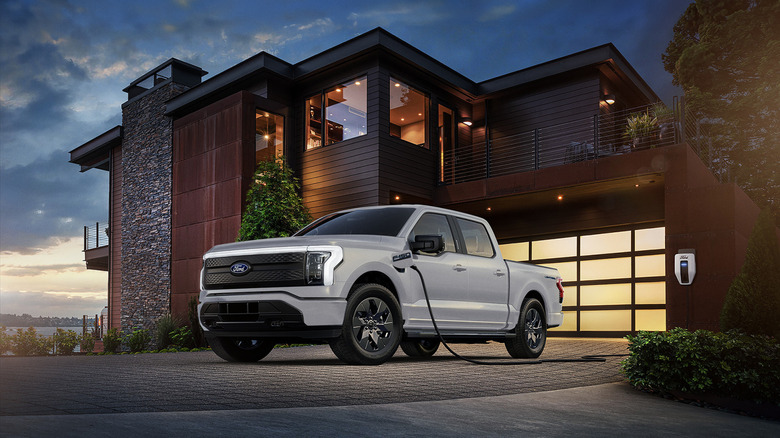What's So Special About The Ford F-150 Lightning Vapor Injection Heat Pump?
Named after the old school Ford F-150 Lightning muscle trucks, the modern-day Lightning represents Ford's take on the EV pickup truck. Thanks to the instant torque afforded by its 452-horsepower dual electric motors, the Lightning boasts some impressive figures and a long list of the latest technology both inside and out.
Ford utilizes much of that technology to make the driver's life easier, either by extending the range with long-distance batteries, fast-charging capability, a plethora of standard and optional interior equipment, and a number of trim levels to suit many different budgets. Тhere is, however, one trick it has up its sleeve which is less obvious and intuitive to grasp: the Vapor Injection Heat Pump.
That's a long and daunting name, so what exactly does a vapor injection heat pump do? To put it in technical terms, it's an on-board refrigerant system with the ability to cool or heat the cabin for use in varying ambient temperatures.
In terms of how such a device works, it's designed with battery efficiency in mind. Traditional vapor compressors, responsible for your climate control, lose power when operating outside of their optimal ambient temperature range, affecting overall range, performance, and reliability.
The F-150 Lightning banks on such reliability to put food on the tables of many owners, so technology such as this can, and has led to a spectrum of improvements, especially in extreme climates. Let's take a look and discuss how it works and whether it's truly that effective, or just another EV gimmick.
How a vapor injection heat pump works
In short, a vapor injection pump solves the problem of how to heat or cool an EV's interior without a traditional internal combustion engine. Usually, EVs run vapor compressors, basically the same thing you'd see on refrigerators and industrial coolers; they can't use a typical HVAC system because heating an interior relies on the heat generated from the engine itself. Ford's vapor injection system, by contrast, uses a patented technique involving a two-stage compression cycle.
It starts off with the compressor absorbing energy to heat the refrigerant. This refrigerant then enters an expansion chamber, which converts the liquid refrigerant into a vapor with a heat exchanger that superheats the fluid. This superheated vapor is then injected in the middle of the compression process, which reduces the workload of the compression by acting as a second stage. This means that the compressor doesn't have to work as hard to produce the same level of heating, and thus improves both overall efficiency and reliability.
Several EVs today utilize such a system, with Ford adopting its own patented variant for model year 2024. Nevertheless, it helps out owners and fleet vehicle customers alike who operate these trucks in cold weather conditions, where running the heater on full blast can significantly lower the range of a battery and overstrain the compressor. By contrast, Ford's system allows for improved heating across the board, or so the company claims. A nice perk for one of the fastest Ford trucks ever produced, to be certain.
Does it actually work as well as advertised?
Sadly, there are few scientific tests which determine precisely how much range is gained from this system versus the older Lightnings. Such a test would theoretically be a 2023 and 2024 model Lightning driving a set range under identical ambient temperature conditions, and while there's plenty of real world testing, it holds up less in terms of scientific validity.
For that, we'll likely have to wait for an accredited journal to conduct a more thorough examination. Similarly, the system is too new for us to fully understand its major downsides in the Lightning. We can look at how it benefits cooling and heating, however.
Science Direct published an article which directly references the F-150 Lightning and other Ford EVs, stating general increases in cooling and heating performance across the board in statistically significant numbers, ranging from about 10% to over 30%.
Of course, those numbers mean little without rigorous real-world testing to back those claims, but from what we've seen, it certainly appears to be a significant improvement in terms of energy consumption. By extension, less energy used by the system means that there's more available to power the truck, and that's good news for long-haulers.
Of course, the vapor injection pump is merely one of a host of changes introduced to the F-150 Lightning for the 2024 model year, with modern Lightnings among the most technologically-packed pickups available on the market.


